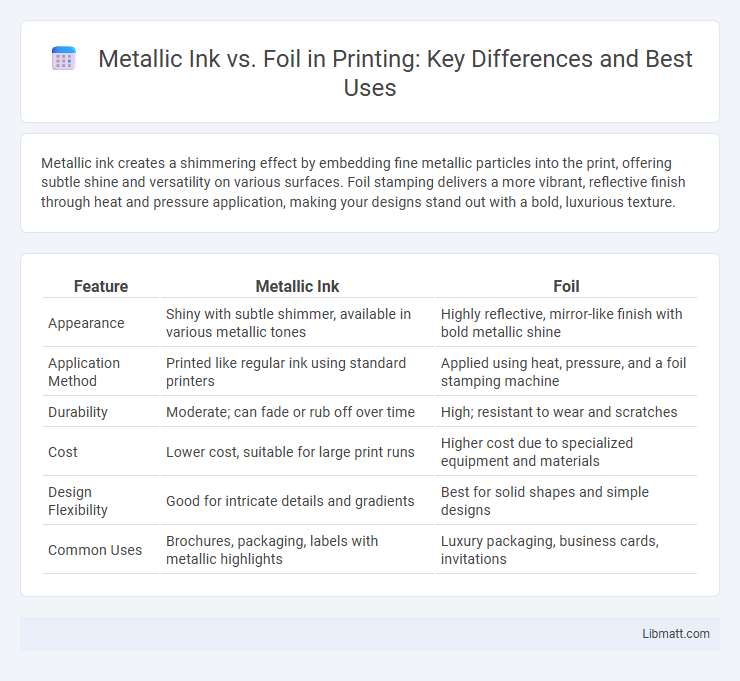Metallic ink creates a shimmering effect by embedding fine metallic particles into the print, offering subtle shine and versatility on various surfaces. Foil stamping delivers a more vibrant, reflective finish through heat and pressure application, making your designs stand out with a bold, luxurious texture.
Table of Comparison
| Feature | Metallic Ink | Foil |
|---|---|---|
| Appearance | Shiny with subtle shimmer, available in various metallic tones | Highly reflective, mirror-like finish with bold metallic shine |
| Application Method | Printed like regular ink using standard printers | Applied using heat, pressure, and a foil stamping machine |
| Durability | Moderate; can fade or rub off over time | High; resistant to wear and scratches |
| Cost | Lower cost, suitable for large print runs | Higher cost due to specialized equipment and materials |
| Design Flexibility | Good for intricate details and gradients | Best for solid shapes and simple designs |
| Common Uses | Brochures, packaging, labels with metallic highlights | Luxury packaging, business cards, invitations |
Introduction to Metallic Ink and Foil
Metallic ink provides a shimmering, reflective finish by embedding fine metallic particles directly into the print, enhancing visuals with vibrant, yet subtle shine. Foil involves applying a thin layer of metallic material, often gold or silver, onto the surface through heat and pressure, resulting in a bold, high-gloss effect ideal for premium designs. Your choice between metallic ink and foil depends on the desired finish, durability, and budget for your project.
What is Metallic Ink?
Metallic ink is a specialized printing ink infused with metallic particles, such as aluminum or bronze, to create a shiny, reflective finish on printed materials. Unlike foil stamping, which involves applying a thin metallic film to a surface, metallic ink integrates directly into the paper or substrate, offering a more subtle shimmer with greater design flexibility. Your choice between metallic ink and foil depends on the desired visual effect, durability, and printing process.
What is Foil Stamping?
Foil stamping is a printing technique that uses heat, pressure, and metallic foil to create a shiny, reflective design on paper or other materials, delivering a luxurious and eye-catching finish. Unlike metallic ink, which contains tiny metal particles and offers a subtle shimmer, foil stamping provides a more vivid, mirror-like shine that can enhance your brand's visual appeal. This process is ideal for adding metallic accents to invitations, business cards, packaging, and promotional materials.
Key Differences Between Metallic Ink and Foil
Metallic ink provides a glossy, reflective finish that mimics the appearance of metal through pigmented particles suspended in the ink, ideal for subtle shine on paper surfaces. Foil stamping uses heat and pressure to transfer a thin layer of metallic foil onto the substrate, creating a more vibrant and durable metallic effect with a smooth, mirror-like finish. Your choice depends on the desired visual impact and application, with metallic ink offering cost-effective, flexible printing and foil delivering premium, high-contrast embellishments.
Visual Impact and Aesthetics
Metallic ink offers a subtle shimmer that enhances designs with a refined, reflective quality, ideal for intricate graphics and fine details. Foil stamping provides a bold, high-gloss finish that creates a striking contrast and elevated luxury feel on packaging and invitations. Both methods enhance visual impact, but foils deliver a more pronounced shine and tactile dimension, while metallic inks offer versatility and smoother gradients.
Durability and Longevity
Metallic ink offers moderate durability with resistance to fading and scratching, making it suitable for long-term indoor applications. Foil stamping provides superior longevity and durability due to its resilient metallic layer that withstands environmental wear and tear better than metallic ink. Both methods enhance visual appeal, but foil's robustness makes it ideal for high-traffic or outdoor items requiring lasting metallic effects.
Cost Comparison
Metallic ink offers a cost-effective solution for adding shimmer and metallic effects to your print projects, typically costing significantly less than foil stamping. Foil requires additional materials, specialized equipment, and longer production times, which generally result in higher expenses. For budget-conscious designs seeking a flashy finish, metallic ink provides an affordable alternative without sacrificing visual impact.
Environmental Considerations
Metallic ink and foil differ significantly in environmental impact, as metallic ink often contains heavy metals and solvents that can be harmful if not properly managed, while foil typically involves the use of plastics and adhesives that contribute to waste and are less recyclable. Sustainable alternatives like water-based metallic inks reduce VOC emissions and toxicity, whereas eco-friendly foil options are limited but improving with innovations in biodegradable materials. Choosing metallic ink with non-toxic, recyclable attributes generally offers a lower environmental footprint compared to traditional foil stamping methods.
Best Applications for Metallic Ink
Metallic ink excels in applications requiring subtle shimmer and detailed designs, such as luxury packaging, high-end branding, and printed marketing materials where precise color matching and fine lines are essential. It is ideal for labels, brochures, and invitations that benefit from a reflective finish without the thickness or texture of foil stamping. This ink offers greater flexibility for intricate artwork on flexible substrates like paper, plastic, and textiles, making it suitable for a wide range of promotional products and decorative prints.
Best Applications for Foil Stamping
Foil stamping excels in creating eye-catching invitations, business cards, and packaging with its reflective metallic finish that enhances brand appeal. Unlike metallic ink, foil stamping delivers a luxurious, embossed texture that stands out in high-end product labels and promotional materials. Your designs benefit from foil stamping's durability and vibrant shine, making it ideal for premium marketing collateral.
Metallic ink vs foil Infographic

 libmatt.com
libmatt.com